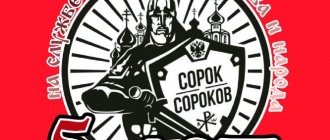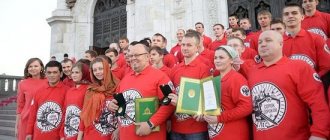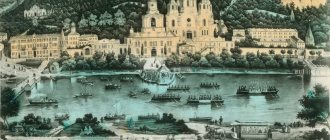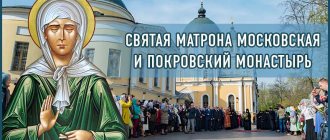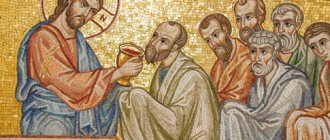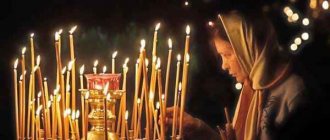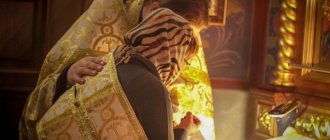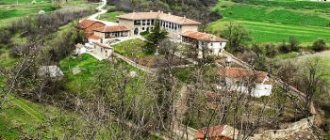The “Forty Forties” movement called on the prosecutor’s office to check Channel One after Vaenga’s speech
The founder of the Orthodox movement “Forty Forties,” Andrei Kormukhin, criticized Elena Vaenga’s speech on Channel One. The singer performed Mikhail Krug’s composition “Golden Domes” in the image of a monk, wearing a false beard. Kormukhin said that this is not the first “blasphemy” that the TV channel has committed, and its management needs to be checked by the Investigative Committee and the Prosecutor’s Office. He also condemned the participants in the MUZ-TV Prize and the St. Petersburg International Economic Forum.
“The first step is to expel Konstantin Ernst from the post of general director of Channel One. This (Vaenga’s speech) is not the first blasphemy that the TV channel he runs has committed against both Orthodoxy and believers ,” Kormukhin said in an interview with the Daily Storm.
The Orthodox activist noted that the policy of Channel One is a reason to bring its leadership to justice, even criminally: “It’s not only Roskomnadzor that needs to figure it out. Both the prosecutor's office and the Investigative Committee need to look into this. Because our state has a national security strategy. And in paragraph 30 and paragraph 43 it is stated that traditional spiritual and moral values are a priority of state policy.”
“The destruction of such values is equivalent to the organization of terrorist groups and color revolutions. If the prosecutor’s office and the Investigative Committee consider such intent on the part of the producers of Channel One and Konstantin Ernst, then it may well be that there is another element of the crime ,” added Kormukhin.
The leader of “Forty Forty” noted that artists are ready to do shameful, in his opinion, acts for the sake of popularity, and recalled recent events whose participants were convicted of promoting non-traditional sexual relationships or insulting patriotic feelings: “The fact that the workers of the artistic workshop behave like corrupt prostitutes is nothing new to us. If for the sake of popularity you have to go out with a bare butt or rooster feathers on your head, they will do it .
“The fact that Vaenga glued on her beard and put on a monastic robe is also [unpleasant] for religious people. It is a revelation for us what has happened to the policy of not only Channel One, but also MUZ-TV and SPIEF - that is, the positioning of various perversions ,” Andrei Kormukhin was indignant. “ The sodomites, apparently, decided about LGBT people with such mass actions as Milokhin at SPIEF, Kirkorov and Loboda on MUZ-TV, Manizha and Vaenga on Channel One.” According to the Orthodox activist, such performances are the purposeful activities of the “sodomite lobby” in Russia.
On June 8, Roskomnadzor announced that it would analyze recordings of the MUZ-TV channel broadcasting the award for violations of current Russian legislation, including in the field of protecting children from information harmful to their health and development. The department promised that if violations are detected, appropriate response measures will be taken, and noted that an audit will be carried out against the organizers of the award.
The MUZ-TV Award was held in the capital at the Megasport sports complex on June 4. Blogger Danya Milokhin was invited to the event, who dressed up as an intersex person. The audience was also surprised by the image of blogger Igor Sinyak, who came to the ceremony in a black women's dress. Blogger Dava and Philip Kirkorov drove along the red carpet in a convertible in wedding tailcoats, surrounded by 10 naked men.
On June 2, Danya Milokhin also pleased the participants of the St. Petersburg International Economic Forum (SPIEF) with his presence. The blogger attended the discussion “Who makes money from whom: bloggers from business or business from bloggers?” He answered questions from journalists, and then taught the audience how to make videos for TikTok. Milokhin invited the forum participants to lie on the floor and put their feet up on chairs.
DSS implements various projects
The basis of brotherhood is conciliarity, the unity of Christians in love, faith, traditions and life. At first, only brothers were members of the Movement. But over time, with the expansion of activities, tasks suitable for women appeared. This is how the direction of sisterhood appeared.
The sisterhood is involved in charity work, working with orphanages and orphans, and holding fairs and master classes.
The “Fight” project involves the protection of motherhood and childhood. Together with the For Life Movement, we managed to install anti-abortion stands in several medical institutions.
“From temple to temple! From soul to soul! is engaged in distributing humanitarian aid to the residents of Donbass.
In addition, they help the homeless of Kievsky Station: they provide social assistance, organize feeding of the poor several times a week; visiting and helping prisoners, fulfilling the Savior’s commandment: “I was in prison, and you came to Me...”.
The holiday “Orthodoxy and Sports” is considered popular and attracts more and more participants and guests
Sports occupy an important place in the Movement. An Orthodox warrior must be strong and fair, protect the weak and not use force for evil. What should Russian athletes strive for?
In addition, members of the Movement have been defending the construction sites of churches in Torfyanka Park since June 2015, where local residents and opposition parties oppose their construction. These events showed that there are many football fans in this movement. Among them was Ivan Katanaev, the leader of the Spartak fan group, as well as Vasily Stepanov, a former member of the Gladiators fan group.
However, in the past Katanaev sympathized with fascist ideology. According to the brotherhood’s leader, A.B. Kormukhin: “for us, he is an Orthodox brother who is looking for a way out of dead ends.”
Therefore, they began to draw a parallel with the DSS with pro-Kremlin movements, these are the “Young Guard” and “Ours”, consisting of fans participating in opposition rallies and rallies.
"Fourty"
The numeral “forty” is unique in its essence. If you look at other words denoting numbers, it will not be difficult to guess how they were formed. For example, “sixty” or “eighty” come from the number of tens they contain: “six tens”, “eight tens”. Following this logic, “forty” should have taken a form like “fourty.” However, this numeral took a completely different path.
Once upon a time, the Slavs, who were engaged in hunting, packed sable skins into men's shirts or shirts. This kind of bag was called “forty”. How did “forty” become a numeral? Everything is very simple. The fact is that exactly 4 dozen skins fit into the bag. This word gradually became associated with this particular number.
An exact number or just a phraseology?
Meanwhile, some suggest that the phraseological unit “forty forty” should be taken literally. Namely, if you multiply 40 by 40, then the answer to this simple example will indicate the exact number of churches that were located within Moscow before the revolution. Andrei Kormukhin, head of the organization of the same name, also thinks so. The Orthodox magazine “Thomas” reports this. It turns out that there were 1,600 churches in the capital at that time?
This version is refuted by Hieromonk Job (Gumerov). On the Pravoslavie.ru website, the priest writes that at that time there were about 800 churches in Moscow. According to the hieromonk, if we take as a basis not the number of churches themselves, but only altars, of which there were different numbers in different churches, then the result is also not will correspond to the 1600s, but will be 20 units more. Thus, the expression “forty forty,” according to Job, does not find confirmation that it should be understood literally. It rather simply refers to a multitude of temple buildings.
Spaso-Andronikov Monastery yesterday and today
The monastery is also called Andronnikov or Andronnikov of the Savior Not Made by Hands. It was founded in 1357 by Metropolitan Alexy. The construction of the monastery was supervised by its first abbot, student of Sergius of Radonezh Andronik, whose name was preserved in the name of the monastery, square, street and alley. Despite the famous names of people with whom the history of the monastery is connected, it cannot boast of a large number of visitors. Perhaps this is due to its location.
Moscow drivers are aware of the complex traffic interchange on Andronikova Square. Eight streets and alleys overlook it. Plus the tram line, an ordinary one, not high-speed, which also does not contribute to improving the road situation. In addition, the territory and main buildings of the monastery are practically invisible from the roadway. On three sides, the streets adjacent to the hill run along a high brick wall and three towers: North, South-East and South-West. And from the side of the square, the main entrance to the monastery - the Holy Gate - is separated from the eyes of passers-by by a small, well-kept square, on the territory of which the Chapel of the Life-Giving Trinity, the monument to Andrei Rublev and the Memorial Stone are located. You can admire the temples of the monastery only from the opposite bank of the Yauza, from the Syromyatnicheskaya embankment.
I am consciously trying to build historical bridges, focusing on the most notable milestones from the monastery’s past and those basic values that help revive the monastery at the present time.
The construction of the temple, and later the founding of the monastery, is connected with the events of 1354-1357, when Metropolitan Alexy of Kiev and All Rus' visited Constantinople twice. Having found himself in a strong storm for the first time, in prayer he promised the Lord, in case of salvation, to build a temple in Moscow. The ship ended up in the Golden Horn Bay of Constantinople on the day of the celebration of the Savior Not Made by Hands.
Related article: Unusual churches and temples - for inquisitive tourists.
Having visited Constantinople again in 1356, Alexy brought to Moscow the Image of the Savior Not Made by Hands - an icon of the early 14th century, which became the main shrine of the Savior Church. The day of the illumination of the temple, August 16, 1357, is considered the date of the founding of the monastery. And in honor of the saving bay, the Golden Horn is one of the tributaries of the Yauza. was called the Golden Horn, and the streets running north of the walls of the monastery later began to be called st. Zolotorozhsky Val, Zolotorozhskaya St., and Zolotorozhskaya Embankment.
Such a scrupulous determination of the time frame is not accidental. They testify that the main temple of the monastery is the oldest among the surviving Moscow churches. Even the Church of the Nativity of the Virgin Mary, the oldest in the Kremlin, has not been completely preserved.
Like most Russian Orthodox monasteries, Andronnikov shared the fate of the Moscow land, all stages of the formation of the Russian state. But the format of the article does not provide for comprehensive coverage of historical events. Therefore, I will limit myself to only the most important dates for the monastery:
- 1368 - after the wooden building was destroyed by fire, the temple was restored in glinfa (thin baked brick, replaced by white stone);
- 1420-1427 – the white-stone Spassky Cathedral was erected, almost in its preserved form to this day;
- 1571 - the monastery, along with Moscow, was burned by the Crimean Tatars under the leadership of Khan Davlet-Girey:
- 1611 – the monastery was destroyed during the Polish intervention;
- 1747-1756, a 73-meter brick bell tower was erected near the Holy Gate, second in height only to the Ivan the Great bell tower in the Kremlin.
- 1812 suffered greatly and was devastated by the French army.
Magpie
Let's return to phraseology. Its origins should be sought in the times of Ivan the Terrible. It was then, or rather in 1551, that the Council of the Hundred Heads was held in Moscow, which was attended by the tsar himself, the boyars and representatives of the clergy. The participants of the Council decided to distribute all Moscow churches into separate entities (districts), called “magpies”. Each of them had its own name and its own priestly elder. This innovation significantly simplified the management of temples.
However, for a long time there were no more than 10 such districts in the current capital. Therefore, it is obvious that the expression became popular among the people later, namely at the very beginning of the twentieth century, when forty people really became exactly 40.
DSS was organized by Orthodox figures Andrei Kormukhin and Vladimir Nosov
The organization "Forty Sorokov" appeared as a response to the attacks on Orthodoxy and the Patriarch in 2012. The construction of Orthodox churches under the “200 Moscow Temples” project was accompanied by attacks and paid provocations.
Believers were beaten, their car tires were slashed, churches were set on fire, priests were given electric shocks. Therefore, the appropriate reaction of a normal person, even if unchurched, but baptized, is to protect. And to prove that Orthodoxy is not a “religion of the weak.” This opinion has developed over the years of godless power.
Andrey Borisovich Kormukhin – coordinator of the 40 Magpies Movement, raising nine children
In the past, Andrey was involved in boxing and water polo. Olga Kormukhina, a rock singer famous in the 1980s, is his sister. Currently performing Orthodox pop. As an Orthodox person, A. Kormukhin believes that you need to be humble in relation to your sins.
But to be an irreconcilable warrior of Christ, if the matter concerns the homeland, family, faith and the weak. He uses the principle: if someone hits you on your left cheek, turn your right cheek and you will receive grace; if you hit a weak person in front of you, break the offender’s jaw, and there will be even greater grace.
Vladimir Nosov is the organizer of the DSS, an international boxing master, a member of the Patriarchal Commission on Culture and Sports. Actively opposed to homosexuals. On social networks he is fighting in this direction together with the “Wolf Homophobe” movement, whose organizers are seeking the dismissal of teachers involved in the work of city LGBT organizations.
